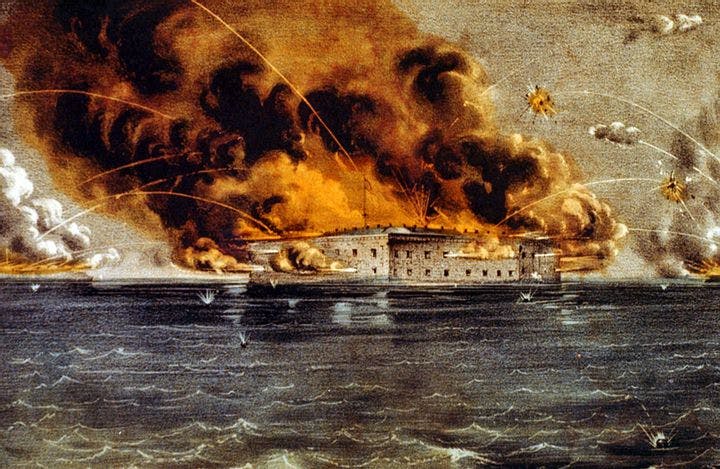Summer 2011
A Moral Question
– Christopher Clausen
It’s hardly surprising that “most people” in the 1860s saw the war in terms of right and wrong; people engaged in warfare generally do.
Readers of The New York Times and Washington Post online op-ed pages were surprised late last year when the two newspapers began blogging a series of events that had taken place a century and a half earlier, starting with the secession of South Carolina in December 1860 and leading within a few months to the Civil War’s first shots at Fort Sumter. Although mostly written by professional historians, these blogs resembled their political counterparts in the sense that they tended to be militantly one-sided. Their authors seemed to feel the need to stand with the North against disunion and, above all, against slavery.
It may seem a quaint moral affectation for historians to line up indignantly against a long-vanished and thoroughly discredited institution at this late date, but academic historiography of the Civil War has been moving in that direction since the civil rights movement of the early 1960s, which coincided with the war’s centennial. Many older historians believed that eventual reconciliation between North and South had led to the United States’ success as a society and world power in the 20th century, and therefore tried to give both sides their due while recognizing their historical distance from us. The newer tendency is to see the war solely in terms of slavery and evaluate the combatants in the light of today’s racial attitudes.
One of the Times’ regular bloggers is Adam Goodheart, director of the C. V. Starr Center for the Study of the American Experience, at Washington College on the Eastern Shore of Maryland, the most “Southern” region of that border state. In his new book about the war’s first months, Goodheart goes so far as to declare, “Americans today find it fairly easy to fathom the idea that there was a right side and a wrong side in World War II, a side that stood for freedom and a side that stood against it. . . . We find it harder, though—much harder than most people did in the 1860s—to accept that there was a right side and a wrong side in our own Civil War. It is difficult to fathom that millions of Americans could have fought as enemies of America.”
It’s hardly surprising that “most people” in the 1860s saw the war in terms of right and wrong; people engaged in warfare generally do. The problem for anyone who aspires to historical perspective is that Southerners saw the rights and wrongs, including the all-important issue of freedom, in the opposite way from Northerners. For us to approach the Civil War with the same reflexes we bring to contemporary politics (with the exception that we think radical Republicans back then were the good guys instead of the bad) obscures the pastness of the past, and allows us to adopt a smug pose toward one side. By the standards of today, after all, both North and South had huge moral blind spots.
Correctly emphasizing that without slavery there would have been no secession and no war does not mean that no other important issues were at stake. Yet the Civil War, Goodheart insists, “is a story of how some people clung to the past, while others sought the future; how a new generation of Americans arose to throw aside the cautious ways of its parents and embrace the revolutionary ideals of its grandparents.” It may be one sign of his distaste for ambiguity that he fails to notice how the second part of this statement applies at least as well to the seceding South as to the Unionist North.
Like other tillers of overworked historical fields, Goodheart tries to make a familiar story new by writing about (and, as much as possible, quoting from) individuals whose varied experiences add new perspectives. While these novelistic passages are well sourced and sometimes absorbing, Goodheart’s relentless stress on his moralistic thesis narrows the range of unfamiliar voices. All the characters he dwells on at length are antislavery Northerners, from future president James Garfield to Elmer Ellsworth, a young friend of President Abraham Lincoln, to Thomas Starr King, an abolitionist clergyman who helped save California for the Union.
Though the story is filled with foreshadowing, Goodheart’s main account ends portentously on July 4, 1861, a few weeks before the war’s first major battle at Manassas. The transformation of the Northern cause from merely restoring the prewar Union into launching a frontal assault on slavery still lay in the future, which gives the book a curiously prefatory feel.
* * *
Christopher Clausen, the author of Faded Mosaic (2000) and other books, writes frequently about the Civil War and historical memory. His most recent contribution to the WQ was “America’s Changeable Civil War,” in the Spring 2010 issue.
Reviewed: 1861: The Civil War Awakening by Adam Goodheart, Knopf, 481 pp. Photo courtesy of the House Divided Project
